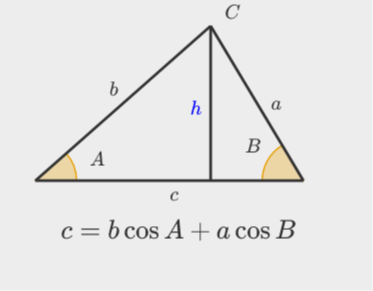Question
If A,B,C are three internal angles of a triangle, show that
\sin^3 A \cos (B – C) + \sin^3 B \cos (C – A) + \sin^3 C \cos (A – B) = 3 \sin A \sin B \sin C
If A,B,C are three internal angles of a triangle, show that
\sin^3 A \cos (B – C) + \sin^3 B \cos (C – A) + \sin^3 C \cos (A – B) = 3 \sin A \sin B \sin C
Since A,B,C are three internal angles of a triangle
A = \pi-(B+C)
Apply the product to sum identity
\sin(B+C)\cos (B – C) = \dfrac{1}{2} [\sin(B+C+B-C ) +\sin(B+C - B-C) ]
Then we get
or
Apply the double angle identity for sines function. Then,
So the first term of the expression on the left hand side is
Similarly, we can deduce similar equations for the second and third terms.
Now apply the Laws of Sines, and let k be the ratio of sines to sides
\dfrac{\sin A}{a}= \dfrac{\sin B}{b} = \dfrac{\sin C}{c} =k
Then we can convert sines function to the multiples of sides.
So LHS is the sum of (5), (6), (7)
LHS = \sin^2 A(\sin B\cos B+\sin C\cos C)+ \sin^2 B(\sin C\cos C+\sin A\cos A)+ \sin^2 C(\sin A\cos A+\sin B\cos B)
=k^2a^2(kb\cos B+kc\cos C)+k^2b^2(kc\cos C+ka\cos A)+k^2c^2(ka\cos A+kb\cos B)
=k^3a^2(b\cos B+c\cos C)+k^3b^2(c\cos C+a\cos A)+k^3c^2(a\cos A+b\cos B)
Expand the brackets, regroup the terms and then factor out common factors
LHS = k^3[ab(a\cos B+b\cos A)+ac(a\cos C+c\cos A)+(b\cos C+c\cos B)]
Apply the projection law formulas
a=b\cos C+c\cos B
b=a\cos C+c\cos A
c=b\cos A+a\cos B

LHS = 3k^3abc
On the other hand, substitute (8), (9),(10) to RHS
RHS = 3 \sin A \sin B \sin C = 3k^3abc
which shows both sides are equal.